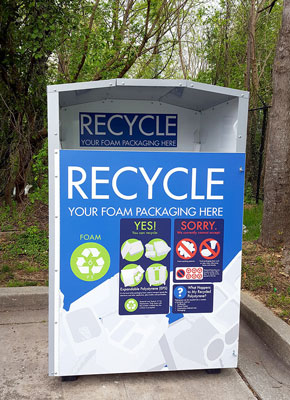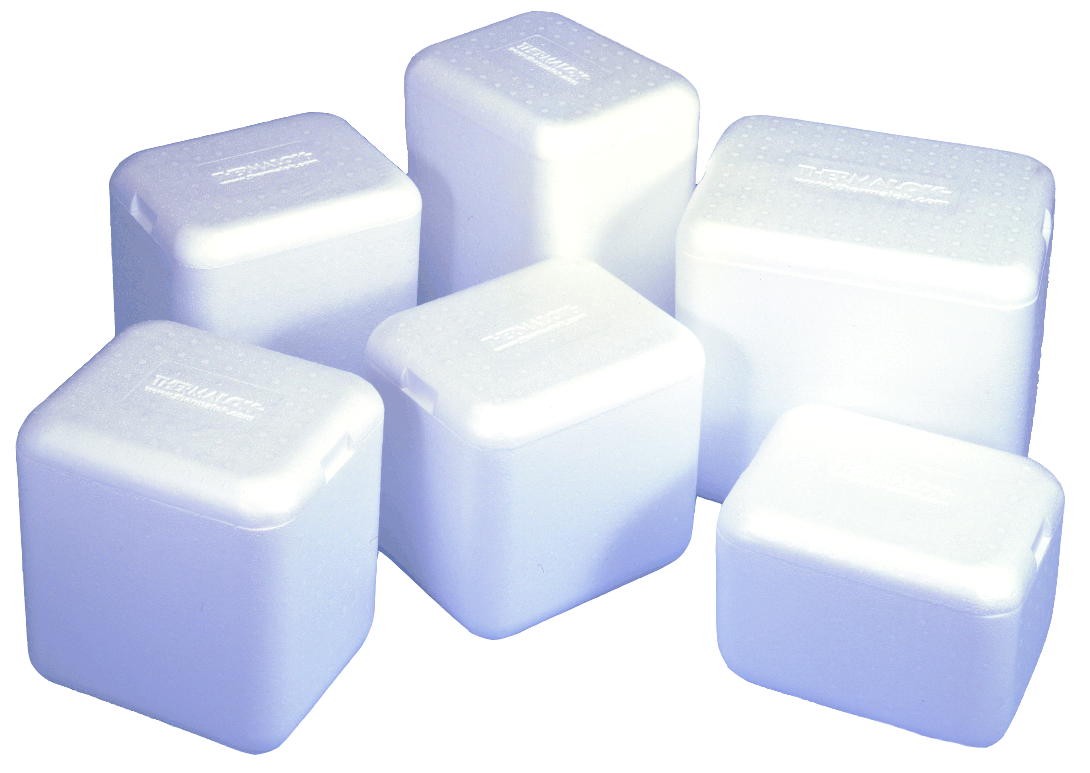Welcome to reuseps! You’ve found the right spot to get help recycling your used packaging – or putting it back into service.

BioEPS is Here!
Now if a piece of molded EPS finds its way into a landfill it will break down in just a few years. This material is still recyclable just like normal EPS – the biodegradability simply adds an end of (useful) life option. This new material has been extensively tested and meets the ASTM DS511 biodegradability spec. When the material breaks down all that’s left is methane (good for waste-to-energy) and water.
This good news material has the same physical properties as typical EPS so it is a drop-in solution. It does cost a little more than regular EPS but not much – about a 10% upcharge on a molded foam part.
How does it work? All plastics are a byproduct of the oil refining process, that makes them organic and thus naturally biodegradable. The variable is at what rate? Typical EPS will eventually break down but it may take 500+- years. By way of an additive normal EPS is changed from hydrophobic (resistant to moisture) to hydrophilic so moisture can sit on the surface of EPS in a landfill. At that point, the microbes in the landfill seek the carbon in the plastic as a nutrient source. As they digest the carbon, they also excrete enzymes and voila – biodegradation occurs (also meeting the ASTM spec). The whole process has been tested and retested, taking four or less years.


Here are some answers to some common questions regarding recycling EPS:
Q – Why can’t I just recycle foam packaging this at my curbside?
A – This has been attempted in several municipalities. The return rates were so low that the programs were not economically viable and consumed more natural resources than they saved.
Q – Do you know why the rates were so low?
A – If you think about it, foam packaging normally only comes into your home occasionally; when you buy something new like a television, computer or appliance, sometimes also with specialty frozen foods. Many paper, glass and metal products are entering your household every single day, largely packaging day-to-day food and beverages items. Bottom line – there is a lot less foam packaging to begin with and not everyone recycles.
For both small and large businesses (receiving foam packaging on a more regular basis) we can and have set up specific recycling programs. If your needs fall into this category, please let us know reusepshelp@foamfabricatorsinc.com or call 888-740-3626.
Q – What foam and/or packaging do you take back and recycle?
A – The simple thing to do is to look for the “reuseps” name and/or a number “6”. If you see this either – it’s Expanded Polystyrene (EPS) or Arcel and we’ll gladly recycle it.
Q – So, is much polystyrene recycled?
A – Yes! Just follow this link for an update and more detail….EPS recycling rates/trends
What do I do next?
1. Reuse. Many civic and community based organizations would love to have a free cooler. Think about food banks, Good Will, animal shelters and fire depts. These are just to name a few we have had very good luck with, re-purposing molded EPS coolers. This is an easy, local and low cost option.
2. Drop Off. Check Our Locations to find our nearest facility to you and if you happen to be near one of our plants, just bring the foam in (note some locations may have limited hours so you may want to contact them first). Don’t have one of our locations near you? Check here to find the nearest drop-off center to you.
3. Ship. Your local post office has at least three sizes of standard mailers (boxes). The large one is 12” x 12” x 5.5”. There are also two smaller ones (11” x 8.5” x 5.5” and 11.6” x 3.3” x 13.8”). Most packaging will fit in one of these. Break the foam up to make sure it fits in the smallest sized box. Box it up and simply mail it to one of our locations or another EPS industry mail-back location and it will get recycled.
Q– Who pays?
A – You have to pay to get the foam to a recycling location. You pay now for all recycling, whether it’s at your curb or you drive it to somewhere. We then absorb the costs (sorting, reprocessing, energy, equipment, etc.) from there. So this is an everyone pitching in deal to make it work. Thanks for helping to do your part!
Q – Why do I have to pay for shipping?
A – Recycling, while positive in many ways, does cost time and money. We have to buy extra equipment, pay for labor, take extra processing steps, etc., and we don’t charge for any of that. We’re doing our part by providing a national resource whereby consumers and businesses can avoid taking packaging to the landfill, if they so choose. Sometimes there’s also a small cost for you doing your part. Either way – by working together, we can get the recycling job done!
And, we all pay for things like curbside recycling anyway as you see in your waste disposal/recycling bill, and property taxes – recycling all materials has a cost.
Q – Where do I find more information about EPS?
A – The EPS Industry Alliance (EPS-IA) has an extensive website providing a great deal of information about material properties, recycling and sustainability facts: EPS-IA.
Q – What if I’m in another country?
A – Follow this link for direct contacts to industrialized countries outside of the U.S. Check here for more general information on global recycling resources outside the U.S.
Q – How does Foam Fabricators recycle the EPS?
A – Most of the time we grind it up and remold the foam into new packaging. However, have you ever noticed those little white particles in potting soil? Do you know what fills many beanbag chairs and doll bodies? What makes lightweight cement and concrete blocks, light? How about plastic decorative wood-like trim? These are just some of the other permanent second life uses of molded foam packaging that we support.
Q – What if my foam does not have a “reuseps” logo?
A – Try to find another number on it, usually a 6 (EPS) or a 5 (EPP – polypropylene). If it’s a 5 or a 6 we can probably recycle it and you can send it. If you have other packaging recycling needs or need help with this program, just email us at reusepshelp@foamfabricatorsinc.com or call us at 888-740-3626.
Q – Do I have any other recycling options?
A – Yes. We’re also part of a larger recycling organization, the EPS Industry Association: EPS-IA. See this website for more free recycling options.
It’s a Good Idea to:
- Seek truth over opinions.
- Think critically about any issue.
- Be open-minded and follow the facts where they lead.

We are here to help. Molded EPS and other similar materials we produce are really good at cushioning and insulation, but are not appropriate for all applications. They should be sourced and used – when and where it makes sense.
All materials have some impact on the environment, unless they are made out of nothing. EPS comes pretty darn close to “nothing” because it’s 98% air, but it does have some impact. The question then becomes, is the impact offset by the utility or service of the material?
Another aspect to the impact issue is what we (consumers) choose to do with the material after it has done its job. Littering is one option – just throw it out the window. That’s not advisable, but it is one action a person can take and sadly some do. There are much better solutions though and far better Good Ideas. We are here to help. Please keep reading…
We produce a lot of insulated shipping containers like the one in this picture, in addition to many other molded foam products and packaging.

A molded EPS box like this is an excellent choice for keeping your product from getting too hot or cold. Largely because it is over 97% air, it is a natural insulator. Think about that – 97% air. If you were designing a new material from scratch and wanted it to be “green” (environmentally friendly) would making it out of almost all air be a good place to start? Yes!
So with molded EPS we begin in a good Sustainable, Clean, Safe, Efficient and Reliable place. To read more about that, click here.
Ok, so that is all good news and a great place to begin, but what to do with this container after it’s done its job? Recycling is one option and you can get assistance with that here, but there are other solutions too. Keep reading to learn more and if you don’t find what you need please feel free to contact us via this email link.
While we’re “talking…” how much EPS is out there anyway?

California Notice: California law prohibits the sale of plastic packaging and plastic products that are labeled with the terms ‘biodegradable’, ‘degradable’ or ‘decomposable’ or any form of those terms, or imply in any way that the item will break down, biodegrade or decompose in a landfill or any other environment. These restrictions apply to all sales in or into the State of California, including such sales over the internet. For sales in or into California, Altor Solutions makes no claims that BioEPS product will break down, biodegrade or decompose in a landfill or any other environment
